If you have ever listened to our Cold Outreach Podcast, you will probably know that we love doing teardowns of LinkedIn messages, or email campaigns we have received.
Some are great, and some are not so great…
In these tear-down episodes, we share thoughts on what the salesperson could have done differently, or if they aced their outreach efforts.
In this article, we will look at 13 sales outreach strategy examples that we received, and tear them down, in the hopes of helping you learn what works and what doesn’t; As well as a step-by-step strategy to help you beat your competitors.
Let’s dive in…
(If you prefer to skip the reading, hop on a free 15-minute sales strategy call with Salesbread.)
Example 1
In this teardown, we share a different angle on how to get backlinks and promoted on other websites.
Below is the email we received from the sales rep:

The subject line reads “guest contribution.”
We were willing to open the email because the subject line piqued our curiosity. One thing we would change is, don’t use capitalization in the first letters.
We really enjoyed reading this email; it was well-written, addressed pain points and they even offered to pay us for our time.
Takeaways from this email
1. Mention pain points
Notice how the writer jumped straight into the pain point.
She mentions “We know that content isn’t always easy to create…”
If content is easy for you to create, then this outreach campaign isn’t going to work for you, but if creating content is a pain point for you or your business, then this email is going to capture your attention.
2. Write personalized messages
If the writer had mentioned something personal in the first sentence along with the pain point, then that would have been incredible.
For example:

If she had mentioned the specific topic that your content is about, this would have been a slam dunk of an email intro.
Remember to always add personalization in any email outreach effort because personalization has proven to capture your potential customer‘s attention.
This helps them see that this email isn’t spam, but rather that the sales professional took their time to really write something that could be of value to them.
Tips on how to write personalized messages for your outreach campaign
Always use the CCQ method for writing a customized intro. This stands for:
- Compliment
- Commonalities
- Questions
So, you would need to find something on social media, or Google about the prospect, to either compliment them on, mention a commonality, or ask a question.
You will have to research each prospect on the list in order to write something specifically for them.
This method applies to email outreach and LinkedIn.
We use this template, and it works really well if you’re addressing pain points.
“How are you dealing with X? PS: I’m asking because. (Give your explanation.)”
That’s it… And it works.
Our best advice is – DON’T BE SALESY.
You just want to hit on, “How’s the challenge?” PS: I’ll fix the problem.”
The less salesy the better, because if your buyer personas are feeling the pain, then that kind of pitch is going to prick their ears.
Whenever you can, apply strength to weaknesses.
Remember – Rather have a small list of prospects and use personalization
If you are looking for outreach tactics that get qualified leads, build a small list of prospects and use personalization.
For example, if you have written for b2b SaaS companies, mention that in your outreach email.
Share some social proof of how your articles have performed in the past and how they helped prospects.
I can tell you now because this email lacked personalization the recipient might be wondering if the salesperson sent this same email to hundreds of other blog owners.
And they could be wondering if they might have any experience writing on their specific topics.
Whereas if the writer had mentioned “We specialize in writing b2b sales articles”, there might have been a greater chance of a “slam-dunk” sale.
Rather build a smaller list based on what’s already performed well and write for a very specific target audience.
3. Be very clear in your messages
This is a straightforward email that gets straight to the point. You as the reader know exactly what they are pitching and why they are reaching out to you.
The reason for the email isn’t hidden in an essay of words.
Remember this for your own effective sales outreach; keep your emails or outreach messages to the point. Potential clients don’t have the time to read through long messages.
4. Use metrics and data to back up your sales pitch
We weren’t so impressed with this part of the email:

It’s good that they were transparent about how the article will reference a client, but instead of saying “The content will be relevant to your readers,” they could have shared some metrics on how their articles have helped get x amount of backlinks or shares on social media.
5. Consider your value proposition
Their value proposition isn’t bad… But they could have increased the amount. (If you think about it, very few people work for $100 an hour.)
It’s also important to note that the reader probably doesn’t want money but would prefer to have quality content written that gets backlinks or social media engagement that will bring them more business.
6. Use a specific call to action

It’s very easy to say: “Sure, send a draft over,” and if it blows your mind, you’re going to post it.
They are willing to do the upfront work, and all you have to do as the reader is say “yes.”
Also, they mention they are there for any questions or concerns, showing that they are serious.
But because they are asking to send over a draft, it might make you wonder if they have just written something that’s being sent to everyone. They haven’t even mentioned what the topic of the article would be about.
A better approach would have been to say:
“Here are 3 topics that we would like to see on your website.”
And if you’re not happy with these topics, we can write something else that we know has had success in your niche in the past.
Once again… Remember to do your own research based on the prospect for successful sales outreach.
Key takeaways for outbound sales teams from the above email
- Keep your emails and outreach messages short and to the point
- Use personalization because you will have a higher response rate
- Research your prospects in order to write personalized messages
- Mention prospect pain points at the start of your messages
- Have a clear CTA
- Add data to your emails for added social proof
- Be transparent
- Rather have a smaller list of prospects and write specifically for them; be specific.
Example 2:
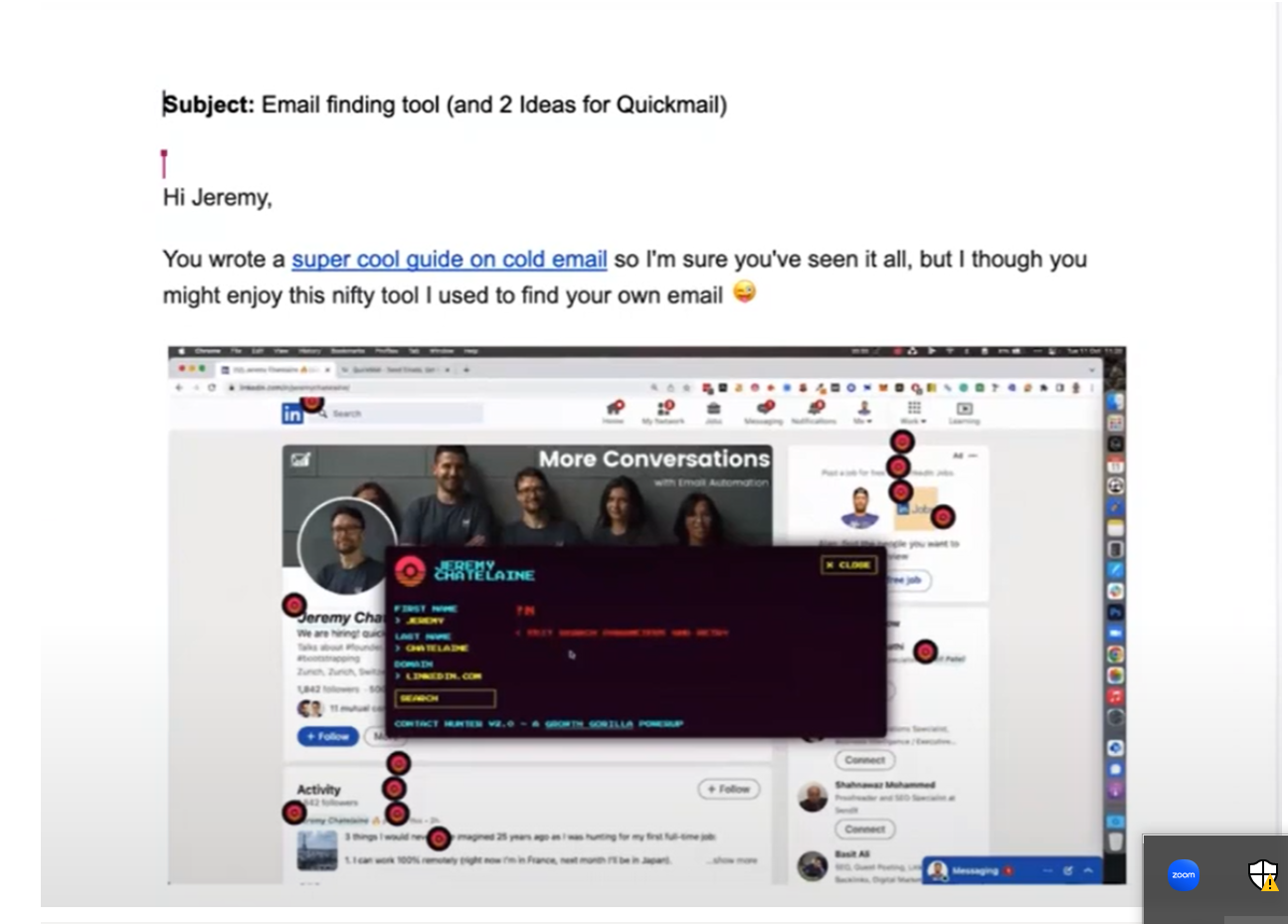
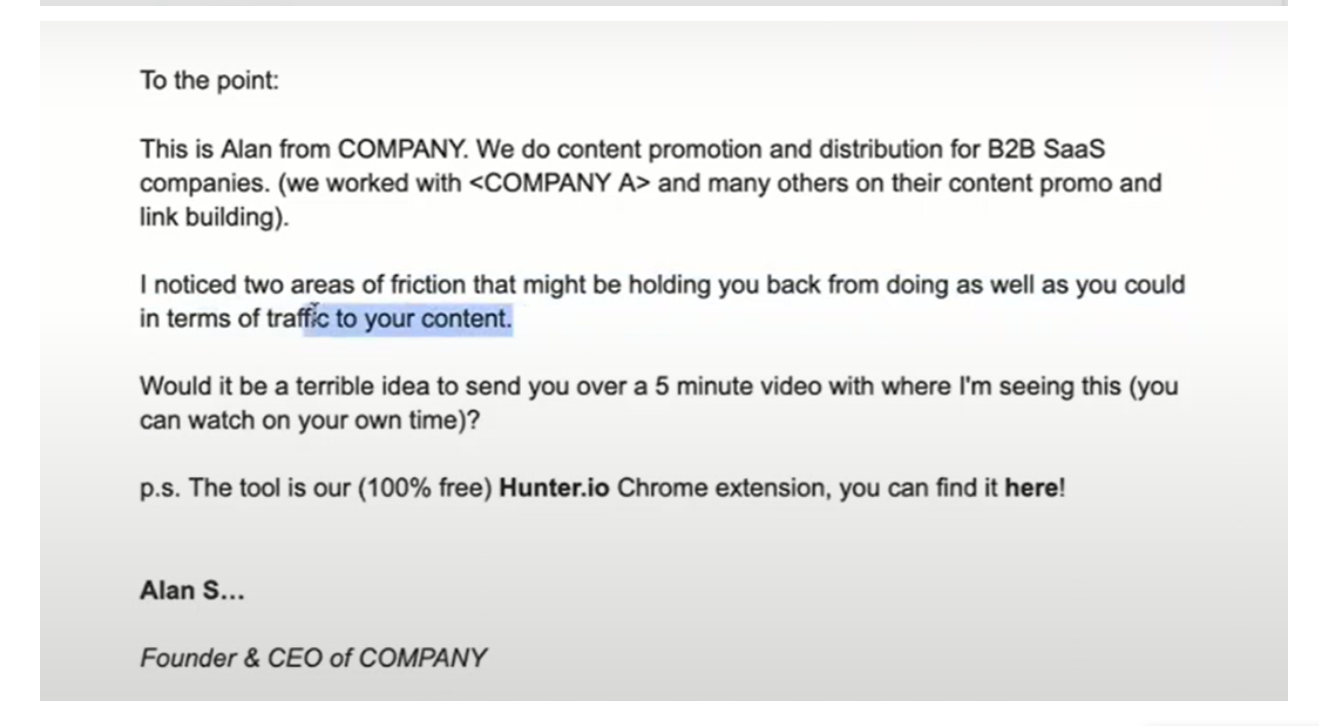
What we noticed about the above email is that they did use personalization.
So, kudos to them.
(Remember to always use personalization in your sales outreach plan. )
They mentioned the guide that Jeremy wrote and shared the link. This means that they probably took some time to research Jeremey and read his guide.
One thing that we thought was a bit bold, was this section in the email:

Why?
Because they are pointing out something that the recipient is doing wrong.
It’s not to say that this strategy doesn’t work, but it could come across as offensive.
Saying there “are 2 areas of friction” could come across as “you screwed up on 2 parts” and it’s holding you back from getting more traffic
If you are going to go the “bold” route, remember to give some more detail on what you saw to be the problem.
But one of the major problems with the above email is, how does this all link to the email-finding tools that were mentioned in the first paragraph?
There is a major disconnect between the “tool” and the “ask” in the email. This is really confusing for the reader.
SO….
6. Keep it simple
Don’t try too many things in your sales outreach strategy. Keep it simple, and to the point. If you look at the above email, there are too many things happening.
There is the image (gif tool), there is the section on website issues, and there is a “PS” at the end mentioning a third item.
All of this can be extremely distracting to the reader. They might not know exactly what you want from them.
7. Remember you catch more flies with honey than you do with vinegar.
Instead of mentioning what they are doing wrong, rather reword it and say: “Hey, I noticed 2 easy improvements that if you do on your website, it will make a big difference.”
- You don’t want to offend your readers.
- Rather positively phrase your sentences.
8. Use videos
We like the idea of adding in a quick video explaining what you do, or even a quick demo video.
The reason for this is that the prospect can be impressed with what you have to offer, and sometimes using video is a great way to do this.
9. Be sure to write valuable follow-up messages
The same marketer above sent about 3 follow-up emails. So, there were 4 touch points in total.
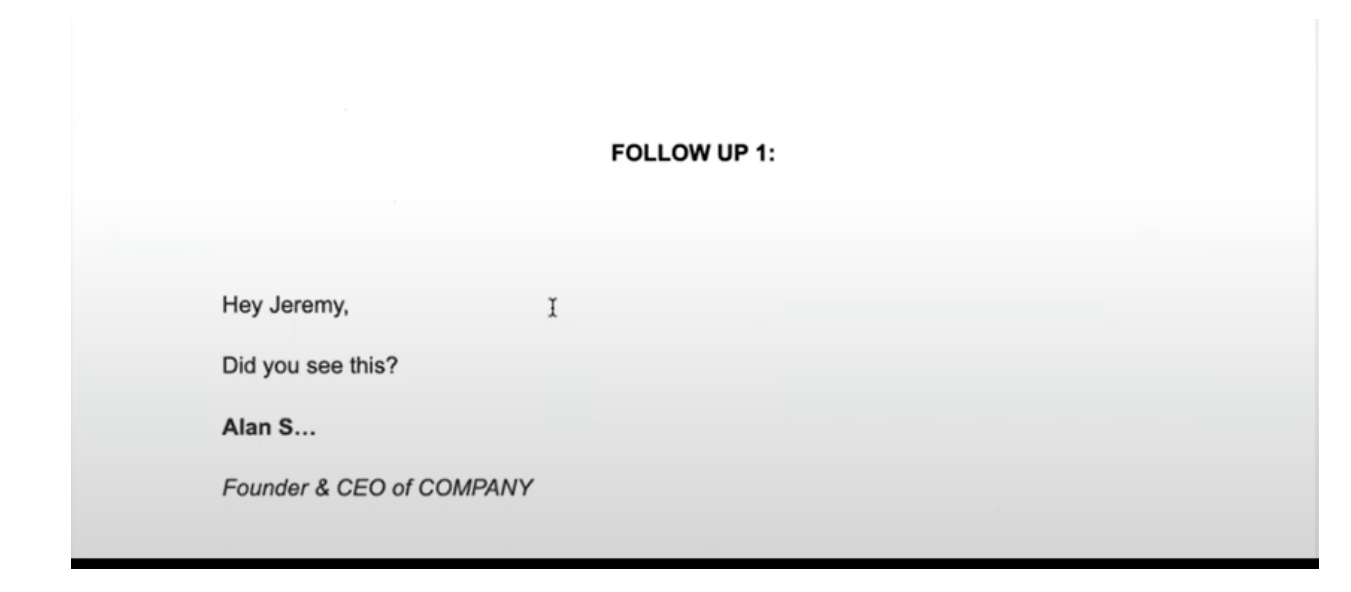
The above was their first follow-up.
As you can see, this follow-up is basically just a “bump” email that offers zero value.
Don’t do this.
For your follow-up add a “teaser”.
They could have rather said something like:
“Hey Jeremy, I probably should have mentioned this, but the optimization has something to do with backlinks on your home page and keywords from a keyword tool. Happy to send it over to you in text format if you prefer.”
They also didn’t use personalization in their follow-up. If you actually think about it, they could have split their first email into two emails.
They could have mentioned their “PS” in this follow-up.
Their second follow-up was way better than the first.
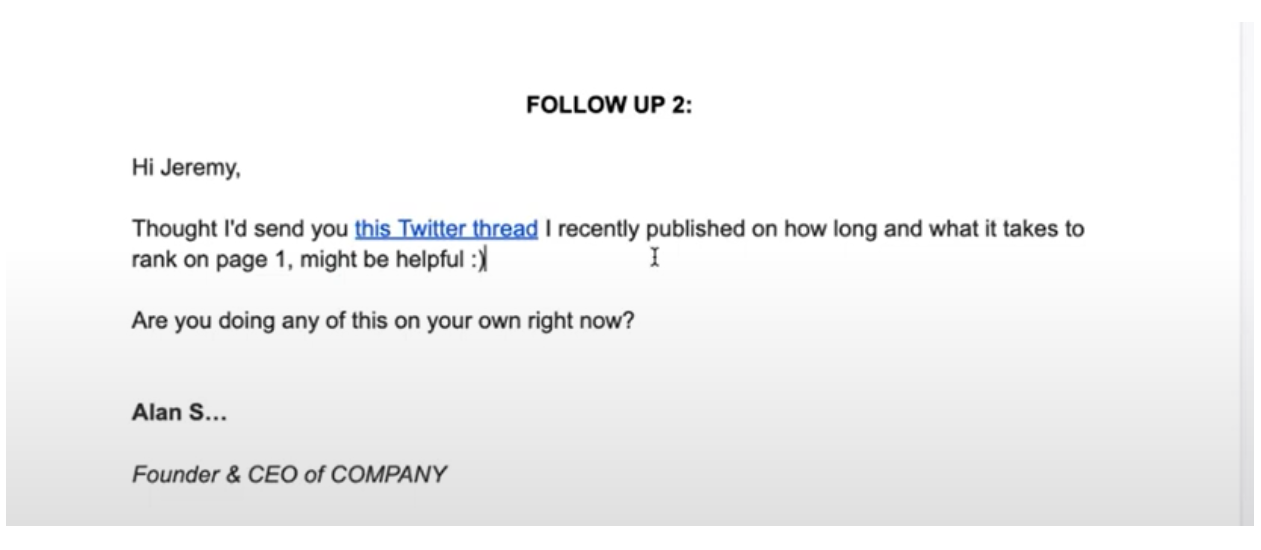
They added a valuable link to the email to a Twitter post that shared how long it takes to rank on page 1.
This is especially valuable if you are an authoritative figure in your niche.
If you aren’t, you might want to skip the links to your social media posts but link to something on your website that shows you’re an expert.
10. Add credibility to your messages
In the last follow-up that this salesperson sent, they missed adding one very important thing; and that’s credibility.
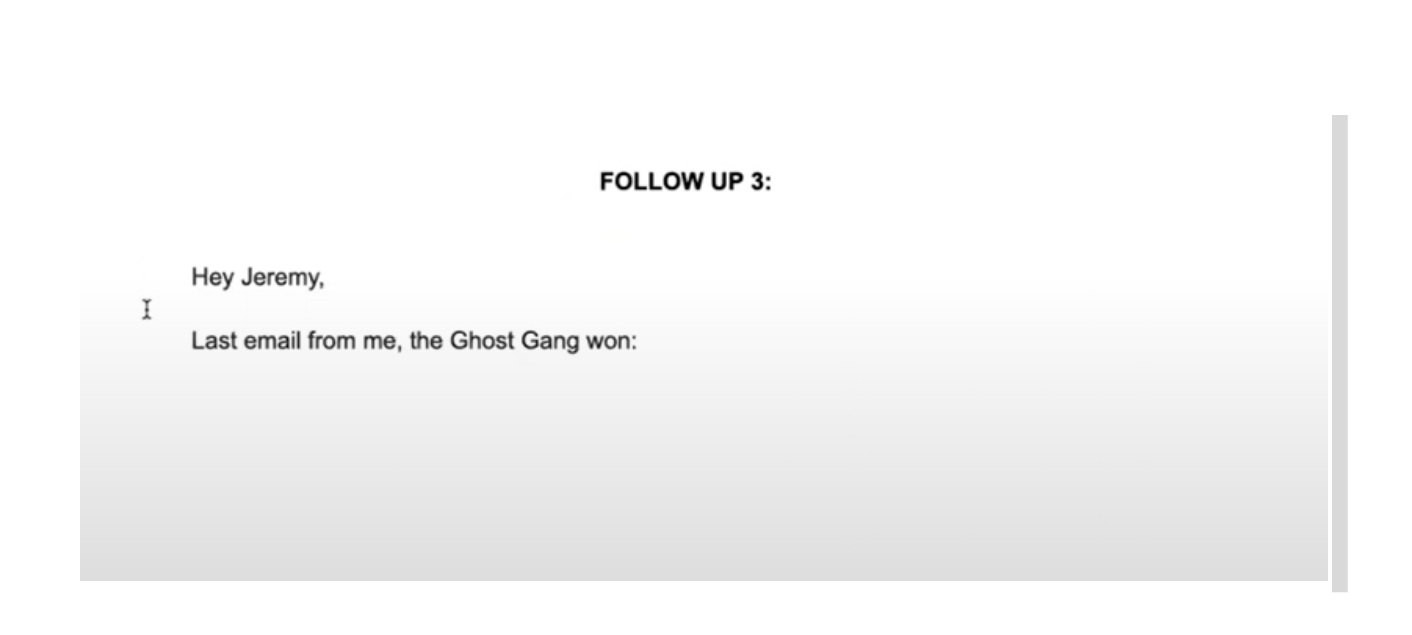
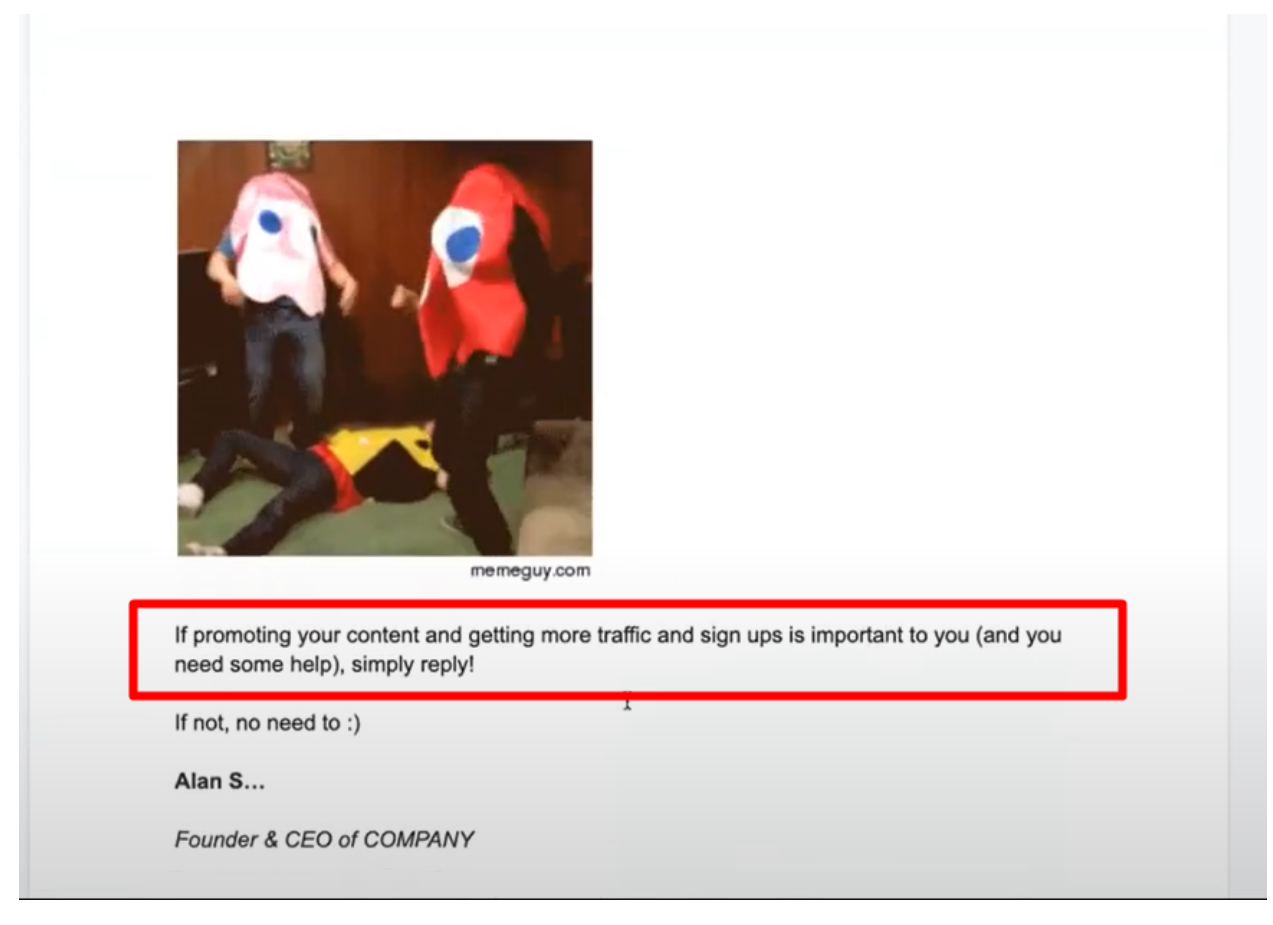
The highlighted passage in this last email is great. But they simply left it at that. A strategy that could have worked is adding some credibility.
They could have added data showing how they helped previous clients.
Graphs from Google Analytics, or testimonials from current customers, could have helped with sales engagement.
So, remember this in outbound sales outreach… Use data. Use testimonials.
Add whatever you can to show that you are an authority in your niche who gets results.
Example 3:
Salesbread is a big promoter of using more than one outreach channel.
We make use of cold email, LinkedIn, and SMS to get in touch with your ideal customers.
If you haven’t tried LinkedIn yet for outreach, then you’re missing out on a huge pool of decision-makers.
(Read this article on LinkedIn outreach and why it works.)
Once you have created a list of your ideal buyer persona, you will then have to send them personalized connection requests on LinkedIn.
In this tear-down, we go through some of the strategies that marketing teams used in their customer outreach.
Let’s discuss what makes a good connection request.
Connection Request 1

11. Don’t use a high “commitment ask”
The above connection request seemed good initially but the “ask” was too high. When they mentioned a free webinar, it killed the engagement.
Why?
Because they are asking you to sit down and use 40 minutes of your time to watch something about a tool you might not even need.
Keep your “ask” simple.
Don’t ask the prospect for something that might take up too much of their time or be too complicated. The less of them ask, the easier it will be for the prospect to reply.
They could have just ended their CTA with: “If you’re interested in learning more could I send something your way? Just reply with yes,”
Connection request 2

12. Be honest about where you found a “referral” …
This is a great connection request.
Why?
Because we would be interested in replying if we knew that there might be a business opportunity. Mentioning a friend might make the prospect curious about who that friend is.
BUT…
If you are going to use this approach for outreach, make sure that you can back up who the friend is.
Don’t be devious in your outreach, because if the prospect asks about which friend gave the referral and you can’t answer them, it’s going to come across as dishonesty.
If you truly know the person who referred you, mention their name.
You could say: “Hey, we have a mutual connection, my friend Jack, told me to reach out to you for b2b lead generation. Would love to connect.”
Connection request 3

13. Don’t make the message all about you, offer the prospect something of value.
Remember when sending a connection request, a prospect doesn’t just have to connect with you just because you’re a fan of their work.
When people use LinkedIn, they might only want to connect with others who can further their careers or build connections with people who might become paying customers eventually.
So, if you are using the above approach, remember to add something of value to your message, so that they actually want to connect with you.
With the above example, the person could have said something along the lines of:
“Listening to you now and subscribed…. Just stumbled upon your podcast and wanted to say thank you for sharing your insights. I’d love to give you a review, could I ask you a few quick questions, care to connect?”
Mentioning that you would like to give them a review is a value add for the reader. Because you are offering them something, they will probably be more willing to connect with you.
Key takeaways to use in your outreach strategies
- Mention the prospect’s pain points and how you can solve it
- Use personalization
- Be clear about why you are reaching out to the prospect
- Make use of data and testimonials for social proof
- Offer the prospect something in return – Whether it’s a Starbucks voucher or money for their time.
- Have a clear call to action that tells the prospect what you want from them
- Keep your message simple and only mention 1 value proposition at a time
- Don’t be offensive by saying what’s wrong with their website etc. You catch more flies with honey than vinegar, so be mindful of how you phrase bold statements.
- Make use of short videos to impress prospects
- Write valuable follow-ups
- Add credibility to your messages – It could be by sharing your Twitter post that has tons of engagement.
- Be honest about why you’re reaching out to the prospect.
- Don’t make the messages all about you and offer the prospect something of value.
Bonus Section:
Sales outreach strategy tips and tricks for beating your competitors
First, consider… should you be targeting competitor companies?
Consider if going after companies that use a service/tool of your competitor is a good idea.
If the answer is yes and there is a very good reason why that company should be switching to you, then target your competitors.
Here are some ways to figure this out…
For example:
- Does your company offer a better service?
- Better support?
- Better pricing?
- Does your tool/service save your clients more time than competitors?
You need to have something significantly better than your competitors.
If it’s a “Coke vs Pepsi” situation. Then don’t bother.
Why?
Because It’s going to be hard to win someone over; there is such a thing as switching costs.
Look for trends when building a list of potential customers
Ask your salespeople if users are switching over all the time from specific competitors. What are the reasons for the switch?
For example, if many of your clients were using the same CRM tool previously, and are switching over to yours instead, you should ask why.
You could get your sales team to ask these questions when onboarding new clients.
- Were they using a CRM tool previously?
- Which tool were they using?
- Why did they choose to switch over to yours?
- What do they prefer about your tool compared to the previous one?
When your company has a clear advantage over your competitor, then it’s an easy win, guaranteed to bring in more moolah.
Don’t go after every competitor or every user. If you want the best results, figure out which inbound leads, or what your sales team’s saying, that’s going to inspire easy wins.
If you know you’re going to win the deal, just go after them.
These decisions need to be based on data and trends that are already happening at your company.
Look for certain signals
You can also look at other signals besides the easy wins that will help you figure out which competitors to target.
This has happened occasionally at SalesBread, where we have been part of campaigns where clients tell us:
“We just found out that our competitor got acquired… (or they closed down;) Quickly find all the companies using this technology, because, in the next 3 months, they are going to have to find another alternative.”
And if a competitor is around long enough, you will see them rise and fall. If you are getting this kind of data, then by all means, use this to form a competitor campaign.
Example:
If you know that a competitor is going out of business, you can send a cold email, or reach out to all their current users on LinkedIn.
In this type of email/ mention the user’s pain points and set up a meeting with a CTA.
Mention a benefit of using your service/tool in comparison to a competitor.
Does your company solve a gap in the market?
If your company solves a specific gap in the market, then go after competitors who don’t have the solution to this problem.
Grab their audience for the best results.
This might not work every time, for example, if it’s a minor feature, then don’t waste your time. It really depends on how painful that problem is to your target audience.
Go after the “untapped users”
Basically, use competitor data to figure out the ideal customer profile of the company that is most likely not to have your solution/competitor solution.
You then find all the players in that market, analyze each one, and find those that don’t have a solution yet.
If someone is still using spreadsheets for example, you could find out if they are going without a solution yet, and they tick all the other data points of being a right fit; then this should be an easy opportunity for effective sales outreach.
Have a different approach from your competitors
If all your competitors offer a tech solution for individuals, and your tool offers a solution for individuals and teams, you could use this advantage to get users who prefer a “team” solution to use your service
If you can manage to have a different positioning in your market that will actually resonate more, then that’s also a good strategy to explore.
Just make it more obvious to users that you offer this unique angle compared to competitors.
Do these strategies work?
Yes, they do.
If your B2B sales team follows the above cold outreach sales process, you will close deals faster than your competitors.
Remember many companies out there are obsessed with automation and use a “spray and pray” sales outreach plan.
Meaning, they don’t build in-depth lists, or personalize every single message that’s sent. This is just too risky.
We would rather obsess about list building and find the exact right people to reach out to for our clients AND use expert personalization than randomly send thousands of the same messages to everyone on a list.
Our metrics below show that this strategy works for generating new business.
In the past 24 months, SalesBread has generated close to 7000 new prospects for our clients.
On average we are seeing:
It’s also important to note that we don’t just use one outreach channel.
Our sales reps use the following:
- Cold email campaigns
- LinkedIn outreach
- SMS
Because we have a variety of channels, it ensures that if we don’t get sales engagement on one channel, we can try a different one.
So, if a prospect isn’t active on LinkedIn, we will reach out to them via email. This is one reason why our response rates are high. A combination of all the above = customer outreach success.
If your company is going after competitors, try the above outbound sales outreach method.
You might just be pleasantly surprised.
Frequently asked questions about sales outreach
What is a sales outreach strategy?
A sales outreach strategy is basically a game plan for how you’ll reach out to potential customers to promote your product or service.
This might include:
- Crafting the perfect cold email to send to prospects
- Cold calling
- Linkedin outreach
- Sms outreach
- Social media outreach
- Content marketing
- Events and networking
How do you develop an outreach strategy?
Developing an outreach strategy starts with knowing who you want to reach out to. Read this article that discusses how to build a sales prospecting list.
It’s important to know who your target audience is and what their pain points are. Then, choose the methods that suit your brand and audience best (email, phone calls, social media etc.). Plan your messaging, set goals, and keep track of how it’s going.
How do you measure the effectiveness of an outreach strategy?
You measure effectiveness by tracking key metrics like response rates, conversion rates, and overall ROI.
CRM software can also help keep tabs on these stats. Keep an eye on how many leads you’re generating and how many of those turn into customers.
What are some benefits of a sales outreach strategy?
Sales outreach can help you:
- Reach new customers: You can connect and engage with people who don’t know about your product/service.
- Build relationships: An outreach strategy will also allow you to form bonds with potential clients over time and this in-turn can lead to new business opportunities.
- Stay organized and focused
- Save you time, streamline your approach and help you close more deals.
The Takeaway
By following the above tips and tricks, you will win over more qualified sales leads, even if you’re going after competitors.
(Have a strategy-related question? We would love to help you. Book a free 15-minute strategy session below.)
